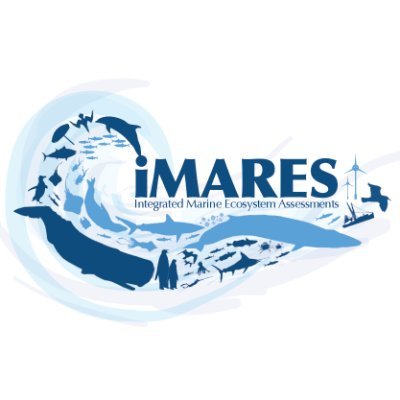
iMARES
@iMARES_group
Followers
232
Following
297
Media
375
Statuses
607
The iMARES (Integrated Marine Ecosystem Assessments) is a marine research group from the @ICMCSIC founded in 2022. 🦋@imares-group.bsky.social
Joined January 2024
@ICMCSIC @LuciaEspasandin @Fran_seabird @ValeSbra @CollMonton 🌍 Climate change is already reshaping Mediterranean fisheries. 📊 With indicators like MTC and MTR, we can anticipate risks and opportunities. 💡 Time to act: science, management, and adaptation. #FutureOfFisheries #BlueTransformation
0
0
1
@ICMCSIC @LuciaEspasandin @Fran_seabird @ValeSbra @CollMonton ⚠️ Species like sardine, hake, and Norway lobster are declining. 📉 Fewer catches, lower income. 📈 But others like red shrimp and anchovy are on the rise. #CommercialSpecies #ClimateAndSea.
1
0
0
@ICMCSIC @LuciaEspasandin @Fran_seabird @ValeSbra @CollMonton 📍 Each port tells a different story. In some places, things are improving. In others, they’re getting worse. 🎯 Fisheries management must be local and adaptive. #LocalAdaptation #SpatialEcology
1
0
0
@ICMCSIC @LuciaEspasandin @Fran_seabird @ValeSbra @CollMonton 🚢 Not all fleets are affected equally by climate change:. 🔴 Bottom trawlers and longliners benefit from warm-water species. 🟡 Surface longliners and small-scale fisheries are losing cold-water species. #SmallScaleFisheries #Resilience.
1
0
0
@ICMCSIC @LuciaEspasandin @Fran_seabird @ValeSbra @CollMonton 🐙 Cephalopods (like octopus) are the big winners. 🦐 Crustaceans are struggling. 🐟 Fish show a clear loss of cold-affinity species. #MarineBiodiversity #ClimateImpacts
1
0
0
@ICMCSIC @LuciaEspasandin @Fran_seabird @ValeSbra @CollMonton 📈 Over 23 years, we saw clear trends:. 🌡️ Mean Temperature of Catch (MTC): +0.68 °C/decade. 💶 Mean Temperature of Revenue (MTR): +0.58 °C/decade. ➡️ We’re catching more warm-affinity species… and earning more from them too. #OceanWarming #Fisheries
1
0
0
@ICMCSIC @LuciaEspasandin @Fran_seabird @ValeSbra @CollMonton 💡 We introduced a new indicator: the Mean Temperature of Revenue (MTR). It shows how climate change affects not just what we catch, but also which species bring in the most money. #BlueEconomy #FisheriesScience
1
0
0
@ICMCSIC @LuciaEspasandin @Fran_seabird @ValeSbra @CollMonton 🌡️ Sea temperatures have risen between +0.35 °C- +0.37 ºC per decade. 📈 This has led to more warm-water species (like red shrimp) and fewer cold-water ones (like sardine or hake). #Tropicalization #Deborealization
1
0
0
🐟🔥 The sea is warming… and that’s changing what we catch and how much it’s worth. 📊 In the NW Mediterranean, we analyzed 23 years of data to understand how climate change is reshaping fisheries. #ClimateChange #Fisheries #Mediterranean. @ICMCSIC.@LuciaEspasandin
1
2
2
🌍🔬 Climate Impact Hotspots Data is an open-access resource by iMARES to explore climate-driven changes in global marine biodiversity. High-res data for research & conservation planning. 📥 Access & download:. 🔗 #OpenData #MarineScience #ClimateChange
0
0
0
@ICMCSIC @CollMonton @ValeSbra @JoanNavarro_ICM @Joan_Gimenez 📚 Want to read the full study?.🔗 👩🔬 Authors: Mar Pardo et al. #MarineScience.
1
2
4
@ICMCSIC @CollMonton @ValeSbra @JoanNavarro_ICM @Joan_Gimenez ❓Are young tuna causing the drop in sardines and anchovies?. 🧠 Not really. 📉 These fish are eaten less by tuna now than in the past.🔁 Tuna adjust their diet based on what’s available.🌍 Many other factors, like climate and jellyfish blooms, also affect fish populations.
1
1
3
@ICMCSIC @CollMonton @ValeSbra @JoanNavarro_ICM @Joan_Gimenez 🔬 What do isotopes tell us?. 📈 In 2018–19, tuna had a narrower feeding range.🐟 Their diet became more specialized.📏 δ15N increased with fish size. #IsotopeAnalysis #MarineBiology
1
0
2
@ICMCSIC @CollMonton @ValeSbra @JoanNavarro_ICM @Joan_Gimenez 📊 Over 30 years:.⬇️ Sardines and anchovies declined.⬆️ Horse mackerels increased.🔁 Juvenile tuna adapt to what’s available.🧠 They’re flexible feeders, not picky eaters!. #Fisheries
1
0
2
@ICMCSIC @CollMonton @ValeSbra @JoanNavarro_ICM @Joan_Gimenez 🍽️ What do they eat today?. 🐟 Mostly fish—especially horse mackerels (Trachurus spp.).🦐 Crustaceans.🦑 Cephalopods.📉 Sardines and anchovies are now less common in their diet. #TrophicEcology #FoodWebs
1
0
3
@ICMCSIC @CollMonton @ValeSbra @JoanNavarro_ICM @Joan_Gimenez 🧪 We analyzed 137 tuna stomachs from 3 time periods:.📅 1989, 2012–14, and 2018–19.🔬 Using stomach content + stable isotope analysis. 🎯 Goal: understand how their diet has changed over time. #MarineResearch #Ecology
1
0
2
@ICMCSIC @CollMonton @ValeSbra @JoanNavarro_ICM @Joan_Gimenez 🌊 Atlantic bluefin tuna are top predators in the ocean. 📉 They’ve been heavily overfished, but thanks to conservation efforts. they’re making a comeback!📈. What does this mean for the rest of the ecosystem?.#OceanConservation #Biodiversity
1
0
2
🚨Paper alert!.🐟 What do young Atlantic bluefin tuna eat in the Mediterranean?.📍 We studied their diet in the Gulf of Valencia over 30 years. 🔍 Have their habits changed? Are they affecting sardines and anchovies?. 👇 Let’s dive in!.@ICMCSIC.#BluefinTuna #MedSea #MarineScience
1
4
12
@ICMCSIC @MariaBas16 9️⃣ 📘 Want to dive deeper? . Read the full article here 👉 #OpenScience #MarineArchaeology.
0
0
0


















